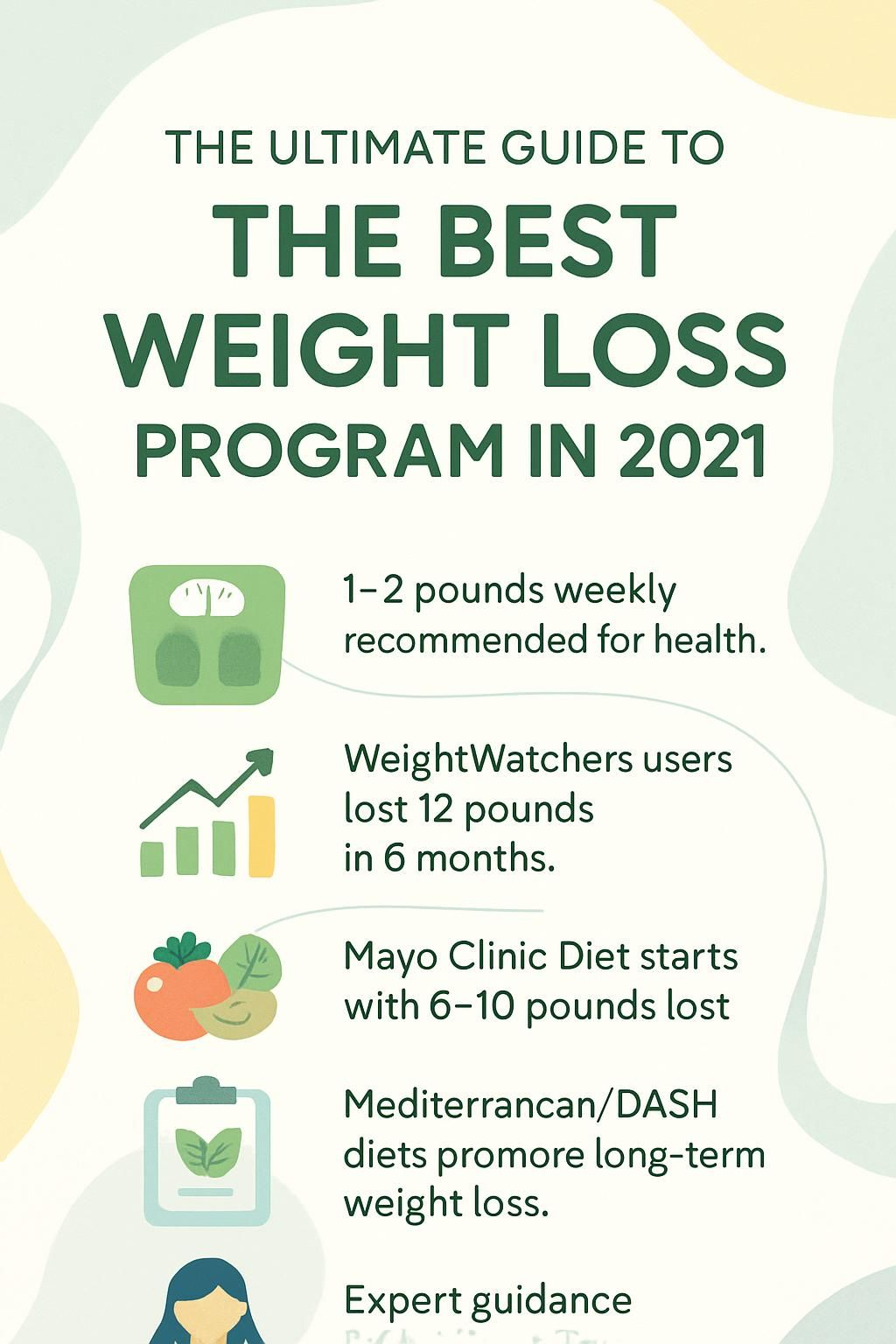The Ultimate Guide To The Best Weight Loss Program In 2021
Our Nutrition Assistant AI Suite will transform your body. You will lose fat, get toned, and build muscle. Gain confidence and optimal health.
Finding the best weight loss program can feel confusing. You want results that last, not a quick fix that fades. Research shows steady changes in food, movement, and daily habits work best for healthy weight loss.
This guide compares top options like WeightWatchers, the Mayo Clinic Diet, the Mediterranean diet, DASH, Noom, and Intermittent Fasting. You will see how each plan works, who it helps most, and how to pick one that fits your life.
Start your weight loss journey here.
Key Takeaways
- Experts suggest losing 1 to 2 pounds per week for lasting health. Programs such as WeightWatchers, the Mayo Clinic Diet, Mediterranean diet, DASH, and Noom support that pace.
- In clinical trials from 2024, WeightWatchers users lost an average of 12 pounds in six months, about 3.5 times more than those without structured support.
- The Mayo Clinic Diet “Lose It!” phase often leads to 6 to 10 pounds lost in two weeks by building healthy habits and increasing activity.
- Mediterranean and DASH diets, ranked highly by U.S. News & World Report, support balanced nutrition, lower disease risk, and gradual weight control.
- Guidance from a registered dietitian or medical expert improves safety and success rates when starting a new eating plan, according to CDC guidance.

Why is Choosing the Right Weight Loss Program Important?

The program you choose shapes your results and your long-term health. A plan that matches your lifestyle and food preferences helps you lose excess weight in a realistic way. It also builds habits you can keep.
A medically guided plan can lower risks tied to type 2 diabetes or high blood pressure. Experts recommend safe, steady loss of about 1 to 2 pounds per week. This rate protects nutrition and helps you keep the progress.
The wrong diet may cause weight cycling, poor nutrition, or health issues. If you have conditions such as obesity or heart disease, talk with your healthcare professional or a registered dietitian before you start. That step keeps you safe and aligns the plan with your goals.
Key Factors to Consider in a Weight Loss Program
Your choice will affect your weight and health over time. Look for an eating plan that supports healthy habits, realistic results, and simple meals you can stick with.
What Are Realistic and Achievable Weight Loss Goals?
Realistic goals protect your health and help you stay motivated. Most experts, including teams behind WeightWatchers and the Mayo Clinic Diet, suggest 1 to 2 pounds per week after any short kickstart phase.
For example, the “LOSE IT!” phase of the Mayo Clinic Diet aims for 6 to 10 pounds lost in two weeks. WeightWatchers users often see about 12 pounds lost in six months, or near five percent of starting weight, based on clinical data.
Losing five to seven percent of your total weight can improve blood sugar and heart markers. This range appears in research from the National Diabetes Prevention Program and follow-up studies on TOPS Club members.
Programs like Jenny Craig have shown greater success than do-it-yourself plans for many women age 45 or older in trials. Regular food tracking also links to better weight control. Clear targets make it easier to follow your plan and see progress that sticks.
How Does Balanced Nutrition Support Weight Loss?
Balanced nutrition gives your body the right mix of carbohydrates, fats, protein, vitamins, minerals, and dietary fiber. Mediterranean and DASH plans focus on vegetables, fruit, whole grains, beans, fish, olive oil, nuts, and low-fat dairy.
The Mayo Clinic Healthy Weight Pyramid puts low-calorie foods like vegetables and fruits at the base. These foods fill you up with fewer calories. Studies from the National Institutes of Health show such meals help control hunger and support heart and metabolic health.
Many plans start near 1,200 calories per day with nutrient-dense foods. That level can support safe weight loss while keeping energy steady. Nutrisystem offers higher protein or balanced menus for different health goals, including menopause support.
During a plant-forward plan I tried through a center for weight management, I noticed better digestion and steady energy. This simple shift helped me avoid snacking at night.
Eating lots of fresh vegetables helped me feel full but stay under my calorie goal,said Maria S., who found success with a Mediterranean diet.
Dietitians often recommend portion control instead of banning food groups. Flexible plans with unlimited produce can reduce cravings and avoid harsh rules found in fad diets.
Why Is Physical Activity Important in Weight Loss?
Physical activity burns calories and supports your weight loss diet. The Mayo Clinic Diet encourages at least 30 minutes of movement per day, such as walking, biking, or taking the stairs.
Strength training protects your muscles while you lose fat. The National Diabetes Prevention Program treats exercise as a core part of long-term change.
Fitness trackers and apps make it easy to log steps and workouts. If you have health concerns or have been inactive, ask your health care provider before you begin a new routine.
Many experts say regular movement helps you keep muscle as you lose weight. In my experience with an in-person program, logging activity kept me motivated and on track.
How Can You Ensure Long-Term Sustainability and Lifestyle Changes?
Choose a program that builds lifelong habits. The Mayo Clinic Diet uses the “LIVE IT!” phase to teach portion control, meal planning, and other everyday skills.
WeightWatchers promotes flexible eating and gradual changes to prevent burnout. Noom offers short daily lessons on behavior change so the new routine feels natural.
Enjoy favorite foods in moderation. This approach, used at WW International, helps you avoid cravings and guilt. Adding more fruits and vegetables also helps with maintenance, as U.S. News & World Report notes.
Keep activity consistent. Data from the National Institute of Diabetes and Digestive and Kidney Diseases shows that exercise supports long-term maintenance.
Strong maintenance support matters. A good program gives tools for social events, stress, and busy weeks. Professional guidance can boost results and safety, especially during medically supervised weight loss.
What Support and Guidance Should Professionals Provide?
Behavior change often works better with coaching. Registered dietitians assess your health, help set goals, and design a weight loss program that fits you.
Plans like WeightWatchers or the Mayo Clinic Diet offer coaching, education, and group sessions for accountability. CDC-recognized programs, such as the National Diabetes Prevention Program, guide you for at least 12 months.
WW includes unlimited virtual workshops led by coaches, plus sessions with registered dietitians and in-app meal tracking. It helps to have support from clinical researchers, behavioral scientists, or medical experts who can explain body mass index, blood pressure, and stress biology in simple terms.
TOPS Club relies on peer encouragement through regular check-ins. Jenny Craig and Nutrisystem provide one-on-one help or app tools for portion sizes and meal planning.
Ongoing feedback from my nutritionist helped during plateaus, and real-time app notes made it easier to adjust when weekly trends changed.
Professional support is essential if you use weight loss medications such as semaglutide or tirzepatide. Licensed providers watch for side effects and support you with guidance from organizations like the United States Department of Health and Human Services. Strong support helps you reach and keep a healthy weight.
Top Weight Loss Programs in 2021
U.S. News & World Report ranked WeightWatchers, the Mediterranean Diet, and Volumetrics among the top choices in 2021. The review also praised Noom, the Mayo Clinic Diet, the Flexitarian Diet, and DASH. It highlighted the Cleveland Clinic diet plan and Ornish as options for weight and heart health.
TODAY.com experts mentioned Nutrisystem and Jenny Craig while noting the growing interest in Intermittent Fasting. These programs promote balanced eating patterns that support steady change. Some use plant-forward meals or calorie limits. Others build habits with technology or coaching from a health care professional.
Meal replacement ideas can support a busy lifestyle. Some programs are virtual, others are in-person. Pick what fits your schedule for better long-term commitment.
Next, see how WeightWatchers works and what sets this approach apart.
WeightWatchers (WW) Overview
WeightWatchers is a popular weight loss program that aims to help you lose weight and protect your health. Keep reading to see how it works and what to expect.
What Is the WeightWatchers Program?
WeightWatchers uses a Points system to guide your food choices. Each food and drink gets a value based on nutrition, portion size, and your personal profile, such as age, height, sex, weight, and goals.
The plan does not ban any food group. More than 350 foods have zero tracking, which lightens your daily workload.
You start with a quick quiz to personalize the plan. The WW app supports meal tracking, camera meal logging for fast entries, macro tracking for detailed users, and recipes with real-time Points.
Members can join unlimited virtual workshops led by certified coaches or use 24/7 in-app chat. WW also offers meetings with registered dietitians who answer nutrition questions.
Some people may qualify for GLP-1 medications through WW Clinic. Those options are supervised by licensed professionals to support safe medical weight loss.
What Are the Key Features and Benefits of WeightWatchers?
WeightWatchers stands out for flexibility and support. You can choose from many ZeroPoint foods, such as non-starchy vegetables, fruits, eggs, yogurt, cottage cheese, fish, shellfish, and lean poultry.
The plan supports steady loss without harsh rules. In a randomized controlled trial in 2024, members lost about 12 pounds in six months, roughly 5.4 percent of body weight. In that study of 376 adults, WW users lost about 3.5 times more than people without support.
The app includes tools for special needs, such as menopause support and diabetes tracking. Regular workshops can double weight loss compared with skipping sessions.
From my experience, weekly workshops kept me engaged and helped me make changes that lasted.
What Are the Pros and Cons of WeightWatchers?
Here are the main pros and cons to weigh as you decide whether WW fits your needs.
| Pros | Cons |
|---|---|
|
|
When I used WW, ZeroPoint foods and flexible Points made tracking feel easy. Weekly weigh-ins felt tense during slow weeks, but 24/7 chat helped me adjust. Think through what fits your style before you choose.
The Mayo Clinic Diet Overview
The Mayo Clinic Diet centers on a healthy diet and lifestyle change. It focuses on building habits that support safe, steady weight loss.
What Is the Mayo Clinic Diet?
The plan has two phases. In the “LOSE IT!” phase, you aim to lose 6 to 10 pounds in two weeks by adding fruits and vegetables, moving more, and avoiding mindless eating in front of screens.
Next is the “LIVE IT!” phase. You continue losing about 1 to 2 pounds per week until you reach your goal weight.
The plan does not cut food groups or require strict calorie counting. You use the Mayo Clinic Healthy Weight Pyramid to guide choices and portion sizes. The goal is to support long-term weight management and total wellness.
Clinicians at the Mayo Clinic designed this evidence-based program to be safe and practical for daily life.
What Are the Key Features and Benefits of the Mayo Clinic Diet?
The Mayo Clinic Diet encourages unlimited vegetables and fruits. You replace unhelpful habits with practical strategies and clear tips.
Tools include a food and exercise journal, a weight tracker, and meal planners. You do not need to count calories or ban entire food types. Eating well and moving more become part of your routine.
Realistic goals help you lose weight without feeling deprived. Many people like the personal guidance that supports long-term success rather than fast results that fade. Expert references, including Hensrud DD, emphasize safe dieting and sustainable change.
What Are the Pros and Cons of the Mayo Clinic Diet?
Review the strengths and limits to see if this plan matches your goals and health needs.
| Pros | Cons |
|---|---|
|
|
The Mediterranean Diet Overview
The Mediterranean Diet centers on fresh vegetables, fruits, whole grains, beans, nuts, and healthy fats. Many people see improved weight control and lower risk of chronic disease on this eating pattern.
What Is the Mediterranean Diet?
This plan emphasizes plants, seafood, and olive oil rather than processed fats. Studies link it to better heart health and lower long-term disease risk. The Dietary Guidelines for Americans 2020 to 2025 recommend this eating pattern.
You focus on positive daily choices, not strict calorie counting. A 1,200-calorie sample menu from Mayo Clinic resources shows how simple meals can support safe weight loss.
Health systems, such as Cleveland Clinic, offer HeartSmart plans that use Mediterranean principles. Many diet apps also use this framework for everyday meals.
What Are the Key Features and Benefits of the Mediterranean Diet?
Plant-based foods anchor the plan. You eat fruits, vegetables, beans, legumes, nuts, and whole grains. Healthy fats from olive oil and fish replace saturated fats.
Meal plans are flexible across calorie levels. Breakfast might be overnight oats with berries. Lunch or dinner could be Tuscan white bean soup or sheet-pan roast chicken with vegetables.
No food group is off-limits. You focus on nutritious options that satisfy hunger. Studies show this pattern can reduce risks for diabetes, high blood pressure, and heart disease. It may also lower body weight and improve A1C, a long-term blood sugar measure.
Trusted sources, including Cleveland Clinic’s HeartSmart plan, support the Mediterranean diet for many ages and lifestyles. Higher fiber supports healthy digestion compared with very low carb or very low calorie patterns that may strain the gut over time.
What Are the Pros and Cons of the Mediterranean Diet?
Consider these points to see whether this lifestyle aligns with your goals.
| Pros | Cons |
|---|---|
|
|
Noom Weight Loss Program Overview
Noom brings psychology and technology together to help you find an approach that fits your life. Keep reading to see how this method supports change.
What Is the Noom Weight Loss Program?
Noom is an app-based program that guides you for about 16 weeks. Its color-coded system groups foods into green, yellow, or orange to teach balance and portion awareness.
Daily lessons explain behavior change in simple terms. You get personalized feedback through the app, not in person. Many users like the flexibility and steady coaching style.
When I logged meals in Noom, I quickly learned how portions affected my day. The design focuses on evidence-based behavior change rather than extreme rules or very low calorie diets.
What Are the Key Features and Benefits of Noom?
Noom delivers short daily lessons to reinforce healthy habits. In-app coaching and tracking offer support and accountability.
The color system makes food choices simple without strict bans. This flexibility helps you stick with the plan during real life events. Meta-analyses suggest Noom can support weight loss by changing behavior.
Everything happens on your phone. Reminders and feedback help you stay consistent over time. This can be more sustainable than harsh diets that lead to weight cycling.
For me, Noom’s prompts helped during stressful weeks. Seeing guided tips in the moment made it easier to pause and pick a better snack.
What Are the Pros and Cons of Noom?
Here is a quick view of Noom’s strengths and limits.
- Pros: Personalized coaching, easy food logging, flexible eating, strong focus on behavior change, full mobile access.
- Cons: Daily logging can feel time-consuming, no in-person sessions, occasional confusion with color labels, limited portion guidance, and higher monthly cost than some plans.
Next, see how the DASH Diet compares for both weight and heart health.
DASH Diet Overview
The DASH Diet was created to help lower high blood pressure. Many people also use it to manage weight and protect heart health.
What Is the DASH Diet?
DASH stands for Dietary Approaches to Stop Hypertension. The plan features fruits, vegetables, whole grains, and low-fat dairy. It limits sodium and reduces processed foods.
Clinicians often recommend DASH for people with high blood pressure. Major health groups, including Cleveland Clinic, rate it highly due to strong evidence for heart benefits.
People who want a nutrition-first approach may prefer DASH over medication or surgery. Next, explore the key features and benefits.
What Are the Key Features and Benefits of the DASH Diet?
DASH centers on nutrient-dense foods like produce, whole grains, and lean protein. It aims to reduce blood pressure and support cardiovascular health without cutting entire food groups.
The plan adapts to different calorie needs. Research from the National Institutes of Health shows DASH can reduce hypertension and may prevent chronic disease. Some people also see a lower risk of diabetes and steady weight loss.
Many choose DASH for a long-term solution. I found that gradual changes worked well, and I lost extra weight over several months without feeling deprived.
What Are the Pros and Cons of the DASH Diet?
Consider these points while you compare DASH to other plans.
DASH can lower blood pressure and improve heart function. The American Heart Association supports this pattern based on consistent results since 1997. You will eat more fruits, vegetables, and whole grains, which add fiber and vitamins.
Still, a large increase in produce can be a big shift. The main aim is heart health, not fast weight loss. Careful meal planning is needed, since there are fewer preset menus than in WeightWatchers or Noom. When I tried DASH, meal prep took extra time, but I noticed lower stress and better sleep after one month.
Intermittent Fasting Overview
Intermittent fasting sets certain times for eating and fasting. Research suggests it can support weight loss and metabolic health for many adults.
What Is Intermittent Fasting?
With intermittent fasting, you eat during set windows and fast during others. Some programs, such as a Jenny Craig schedule, use a 10-hour eating window and a 14-hour fast.
People may combine fasting with meal delivery or clear nutrition guidelines. Fasting styles vary, yet all limit eating times to reduce calorie intake over time. If you take medication or have a medical condition, get medical guidance first.
This strategy can affect stress levels and how you feel day to day. Professional support helps you apply it safely.
What Are the Key Features and Benefits of Intermittent Fasting?
Structured eating windows can simplify planning. Many plans do not require calorie counting during eating periods. That allows you to focus on healthy choices rather than tracking every bite.
Some services combine fasting with meal delivery for convenience. Studies suggest intermittent fasting can support short-term weight loss and improve insulin sensitivity. When combined with balanced nutrition from the Mediterranean or DASH diets, it may also protect against chronic disease.
Many people like the clear rules on eating times. This structure can fit work and home routines. A systematic review found adults using intermittent fasting often do better than with standard calorie restriction alone.
What Are the Pros and Cons of Intermittent Fasting?
Consider both sides before you add fasting to your routine. You may see quick early loss because you shorten eating hours. Clear timing rules can help if you prefer structure. This method also pairs well with a Mediterranean-style meal plan.
It does not require counting calories at every meal, which suits busy days. Still, fasting is not for everyone. Some people should avoid it unless a clinician says it is safe. Fatigue and headaches are common in the first week. I noticed those effects when I tried a plan with coach emails for support. Long-term success depends on lasting habits and sound nutrition. Without those, the lost weight can return.
How Do I Choose the Best Weight Loss Program for Me?
You deserve a program that fits your health and your daily life. Use the steps below to match your needs and goals.
How Should I Consider My Health Conditions?
Talk with your healthcare provider before starting, especially if you have medical conditions. Plans like the Mayo Clinic Diet are safe for most people but may need changes for diabetes or other needs.
GLP-1 medications, such as those offered through WW Clinic, require a prescription and close oversight. Some programs include options for diabetes management, including WeightWatchers and the Mayo Clinic Diet.
If you have health issues or are inactive, ask your provider about exercise choices. Avoid programs that sell compounded semaglutide without licensed oversight.
Options like the National Diabetes Prevention Program may have enrollment rules based on health status. Choose a program that fits your medical needs and supports lasting results with expert guidance.
How Can I Assess My Lifestyle and Preferences?
Think about your routine, your work, and your free time. App-based plans like Noom may suit busy days. Programs such as WW or TOPS Club offer in-person or virtual groups.
Decide if you enjoy social settings or prefer self-guided work. Also consider your food culture and favorite flavors. Flexible meal planning helps. WeightWatchers, for example, offers ZeroPoint foods so you can include favorites without tracking everything.
Consider the type of support that keeps you going. You may want one-on-one coaching, digital reminders, or peer groups. Check how much time you want to spend logging meals and activity. Pick a plan that matches your style, not someone else’s.
How Do I Evaluate a Program’s Cost and Flexibility?
Compare prices before you commit. Costs vary widely. TOPS Club is about 70 dollars per year, which is very affordable. WeightWatchers starts near 23 dollars per month, and free trials appear at times.
Nutrisystem and Noom usually cost more. Jenny Craig can cost more if you choose packaged meals and extra coaching. Review what the fee includes. Some plans add charges for meal plans or app access.
Check employee or insurance benefits. Some employers cover parts of the National Diabetes Prevention Program. Flexibility also matters. WW and the Mayo Clinic Diet offer various food choices and tracking styles. Self-guided plans give lower-cost options without required meetings. Pick a plan that fits your budget and schedule.
What Role Does Exercise Play in Weight Loss Programs?
Exercise is a core part of most plans. The Mayo Clinic Diet suggests at least 30 minutes of activity daily, such as brisk walking or resistance training.
The National Diabetes Prevention Program also includes physical activity to support weight loss and long-term health. Movement does more than burn calories. It helps you keep muscle and improves energy.
Many apps track steps and workouts. The Cleveland Clinic Diet App can log activity so you can see progress each day. Small changes count too. Taking the stairs or walking during calls can add up.
I started a doctor-advised plan due to inactivity. Short daily walks gave me more energy and better control than diet alone. If you have health issues, ask your provider before you begin a new routine. Studies from groups like Mayo Clinic and Cleveland Clinic show that regular exercise helps you keep lost weight off.
What Are Common Weight Loss Challenges and Solutions?
Most people face setbacks at some point. Here are common problems and simple fixes to keep you moving forward.
How Can I Stay Motivated During Weight Loss?
Noom offers daily lessons and reminders that support motivation. Coaching and group support, used in WW and TOPS Club, provide encouragement during tough days.
WW members who join workshops lose about twice as much as those who skip them. Journals and trackers keep your progress visible. Digital apps show trends with charts so you can see wins clearly.
The Mayo Clinic Diet shares simple ideas to lift your mood when motivation dips. I found that logging every meal with Noom made small gains visible, which kept me focused on the next goal.
How Do I Overcome Weight Loss Plateaus?
Plateaus are common, even with a well-matched plan. Adjust your activity and food choices to nudge the scale. Try adding 10 to 20 minutes of brisk walking or swap higher-calorie snacks for fruit or yogurt.
Use an app to track meals and workouts. The data helps you find hidden habits. Ask for support from a coach or peers. Review and update your goals so they stay realistic.
I hit a stall after six weeks. Changing my breakfast to include protein and produce helped me resume steady loss. Flexible plans make it easier to reset and keep going.
How Can I Prevent Regaining Weight After Losing It?
Focus on habits you can keep for life. Track meals and activity to keep your plan visible. Set realistic goals and use support from friends, groups, or coaches.
Some people do best with a program customized to their needs. Enjoy flexible eating while paying attention to portions. Add fiber from fruits, vegetables, and whole grains to stay full. Aim for at least 30 minutes of movement most days.
Rotate meals to avoid boredom and reduce the urge to return to old habits. Keep going, even if progress slows for a while.
What Are Red Flags to Watch for in Weight Loss Programs?
Some offers sound exciting but carry risk. Learn the warning signs before you sign up.
Why Should I Avoid Unrealistic Claims or Promises?
Be careful with programs that promise big results without asking you to change how you eat or move. Such claims often push unhealthy steps, like skipping meals or using unregulated supplements.
Promises of rapid loss with no behavior change usually lack strong evidence. Choose plans that favor gradual improvement with professional support. Slow, steady change builds habits that last and protect your health.
Health experts recommend education, nutrition guidance, and ongoing support instead of risky shortcuts. This approach is safer and more effective for the long run.
What Are the Dangers of Fad Diets with Extreme Restrictions?
Extreme diets often limit key nutrients. You might lose weight fast at first, but most people regain it later. Strict rules can also lead to binge eating or guilt because hunger and cravings build up.
Trends from the past three decades show that many rapid plans do not support long-term health. I tried an extreme low carb plan one summer. I felt tired from missing vitamins and ended up gaining back more than I lost within months.
Choose safer options that support balance and steady progress.
Summary Table: Dangers of Fad Diets
| Issue | Impact |
|---|---|
| Nutrient deficiency | Low energy and weaker immune response |
| Unhealthy behaviors | Binge eating and guilt around food |
| Unsustainable results | Rapid regain once normal eating resumes |
Frequently Asked Questions About Weight Loss Programs
Here are answers to common questions that can help you choose a safe plan and make steady progress.
How Much Weight Can I Expect to Lose?
Your results depend on the plan, your consistency, and your support system. On the Mayo Clinic Diet, many people lose 6 to 10 pounds in the first two weeks during “LOSE IT!” Then they aim for 1 to 2 pounds per week in “LIVE IT!”
On WeightWatchers, most members see a steady average of 1 to 2 pounds per week. One clinical trial reported an average of 12 pounds lost over six months for people who stuck with the plan.
Some programs with strong professional support show greater loss over a year. In my journey, I saw progress when I tracked meals and activity daily and checked in with a coach. Results vary based on effort, health, and environment.
Are These Programs Safe for Everyone?
Speak with a healthcare provider before you start, especially if you have diabetes, allergies, or other health concerns. The Mayo Clinic Diet often needs adjustments for people with diabetes. A clinician can help you make safe changes.
If you have soy or peanut allergies, Nutrisystem may not fit due to ingredients. People with gallbladder issues or irritable bowel syndrome should avoid the Keyto Diet because its limits can worsen symptoms.
Some plans focus on lifestyle change, while others are hard to maintain. Nutrisystem can be challenging for long-term results for certain users. I once tried a plan that did not fit my health needs and had side effects that a quick consult could have prevented. Match features to your history and goals.
Summary Table: Health Considerations by Program
| Program | Use Caution If |
|---|---|
| Mayo Clinic Diet | You have diabetes and do not plan modifications or follow-up |
| Nutrisystem | You have soy or peanut allergies |
| Keyto Diet | You have gallbladder problems or irritable bowel syndrome |
Always check with professionals who know your history. A safe plan supports both health and weight loss goals.
Can I Follow a Weight Loss Program Online?
Yes. Many programs work fully online, including WeightWatchers, the Mayo Clinic Diet, and Noom. These offer meal planning, food tracking, and group support in apps or virtual sessions.
Nutrisystem adds packaged meals with one-on-one coaching. WeightWatchers offers doctor-recommended strategies and digital tools for tracking.
Research shows good results online. WW members tend to lose nearly four times more than do-it-yourself users. Online workshops can double success compared with skipping meetings. If you have medical concerns, talk with a clinician before you start.
Conclusion
The best weight loss program is the one you can follow with confidence. Look for healthy weight loss based on balanced nutrition, regular movement, and ongoing support. Plans like WeightWatchers, the Mayo Clinic Diet, the Mediterranean diet, DASH, and Noom can all work if they fit your life.
Use simple tools such as food journals, step counters, or diet apps to stay aware of progress. Be cautious of quick-fix promises. Slow and steady change usually leads to lasting results and better health.
This article is for education only. For medical advice, diagnosis, or treatment, consult your healthcare professional.
FAQs
1. What makes a weight loss program tailored to individual needs?
A program tailored for weight loss considers personal factors like age, health status, activity level, and food preferences. This approach increases the chance of long-term success.
2. How can I find the best weight management plan in 2021?
Look for programs that use evidence-based methods and offer plans tailored to your goals. Check if they provide support from qualified professionals and track progress with clear data.
3. Why is it important for a weight control strategy to be personalized?
Personalized plans address unique challenges such as medical conditions or lifestyle habits. A program tailored this way helps people stay motivated and achieve better results.
4. Are there risks in following generic diet routines instead of a program tailored for me?
Generic diets may not meet specific nutritional needs or fit your daily routine; this can lead to poor outcomes or health issues over time. Choosing a program tailored to you reduces these risks by focusing on safe, effective strategies.
Summary: Programs designed around individual needs improve safety and effectiveness in managing body mass reduction goals compared with one-size-fits-all approaches.







